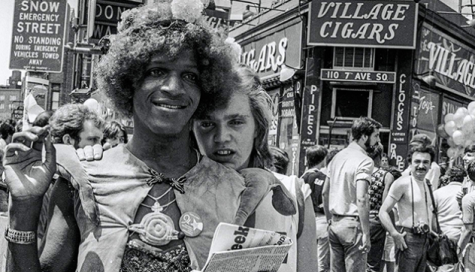Keeping up with the Drag Queens
May 17, 2022
My grannie always ask me the same question “What do you want to do when you grow up” While she expects me to answer with a lawyer, or doctor, or even a teacher, I respond “Sorry grannie, my dream is to star on Keeping up with the Kardashians” one of the trendiest shows in the world. I want to be a part of the 20 seasons showing the Kardashians fight, comfort each other, and get into messy situations. What better way to do so than writing a book! As I began the writing process, I discovered that a lot of what I loved about the Kardashians was inspired by another community with a great sense of fashion, glamor, and style- Drag Queens.
Former Kardashian makeup artist, Joyce Bonelli, said that her techniques are inspired by “drag anything and everything.” And yet, despite how they’ve positively affected the world, and the Kardashians, Drag Queens often suffer from unfair hostility, anger, and repression…it’s time that changed. So today, we are going to open the book and establish the plot by examining the history of drag queens, then we will skip to the climax and explore the positive impacts they’ve had on society, and finally we will study the theme and discover the lessons drag queens can teach us today — because it’s time we Keep Up with Drag Queens.
Establishing the Plot. Joe Jeffreys, a drag historian and professor of theater at New York University, defines drag in an interview with TIME magazine by saying it “is a theatrical form” used whenever someone puts on “clothing that is considered to be not appropriate to them, and then wears it with some type of ironic distance.”
This definition from Jeffery allows us to trace the roots of drag queens all the way back to the 17th century. When playwright William Shakespeare staged plays such as Romeo and Juliet, the female characters were always portrayed by men because women were barred from the acting profession. The costumes of these cross-dressing performers would often consist of long skirts, heavy makeup, and a feminine appearance.
But the first person to officially wear the title of drag queen was William Dorsey Swann, who was born into slavery in 1858. After the Civil War, Swann’s parents bought a farm and he soon started working as a hotel waiter. In the 1880s, he started to organize balls, calling himself “the queen of drag.” Several times, Swann was arrested in gay bar raids, and was even falsely imprisoned in 1896. He asked for a presidential pardon from President Cleveland, which was denied. But by doing so, he officially became the first person to use legal action to fight against LGBTQ discrimination.
Soon after that, men started openly impersonating females as an entertainment style, often performing in Vaudeville shows and bars. That was until in the 1930s, when scientists who studied sexology made connections between drag queens and homosexuality. This led to the Masquerade laws which made cross-dressing illegal. Drag queens were shunned, and these once openly gay bars were forced to move underground which was often targeted by police raids.

In 1969, police raided Stonewall Inn but the LGBTQ community had had enough. They began a series of demonstrations because of targeted police raids that lasted six days. Drag Queen Marsha P. Johnson, a black transgender activist, played a
significant role in the riots as one of the initial instigators. According to an article published in the National Geographic on June 20th, 2020, the Stonewall riots helped “spark the modern LGBTQ civil rights movement.” After the Stonewall riots, her activism continued and she helped form the Gay Liberation Front., made the STAR program where homeless LGBTQ youth could be safely sheltered, and fought against the spread of AIDS.
Let’s skip to the climax. The impact of Drag on social movements cannot be understated. In June 2020, when the movement ‘Black Lives Matter’ mobilized nation-wide, following the murder of George Floyd. Several black drag queens hit the streets, not in violence, but peacefully protesting police brutality and racial injustice. Despite the risk of marching on the street in full drag, famous drag queens such as Jo Mama, Harmonica sunbeam, and Bob have been fearlessly fighting injustice by; organizing protests, creating fundraisers, giving a voice for black LGBTQ community members, and using their social media platforms to educate and support the BLM movement.
Another important effort from the drag community is “Drag Queens Story Hour” a national program where drag queens read to children in public libraries, giving kids a positive outlook on gender fluidity. In spite of the program helping literacy and creating inclusiveness, there has been overwhelming pressure to ban “Drag Queen’s Story Hour” across the United States. Legislators in Minnesota, South Dakota, Missouri, and Tennessee have all made prominent efforts to permanently ban “drag queen story time” from public libraries despite it being strictly voluntary and positively affects children.
Even with all of this hatred still aimed towards Drag Queens, the queen of drag, RuPaul, has made drag culture more normalized through the 3 time Emmy award winning show RuPauls Drag Race. This TV show features several drag queen contestants battling to see who can be America’s next drag queen superstar. An article from New Face Fashion Magazine says that ““RuPaul’s Drag Race” has opened a space for drag voices to be seen, heard, and accepted.”
The Theme: Even if you don’t fully understand the concept of drag queens, we can still learn valuable lessons from them. First, the movement teaches each of us to be true to ourselves and to not succumb to societal norms. Like RuPaul said “If you can’t love yourself, how the hell are you going to love someone else?” But the movement goes far beyond just accepting yourself, but accepting others for who they are. When we accept ourselves, we accept others too.
For Example, the Tony Award Winning Musical Kinky Boots introduces us to drag queen Lola, who helps save Charlie Price’s shoe factory. Throughout the musical, the primary focus isn’t really about shoes, but more about Lola and Charlie’s relationship and validating others. According to New York Lifestyle Magazine, “At the end of the day, Kinky Boots is about acceptance – accepting yourself and accepting other people for who they are: the importance of kindness, understanding, and friendship.” Think of it this way, if we all start judging everybody for everything that they’re not, then this world would be a darker place. But by welcoming others, and more specifically drag queens, we learn that even though drag might be out of the ordinary, it can still make the world a better place by showing us all how to be ourselves. Drag Queens also exhibit how to use the worst part of our lives to create the best aspects of our personality by accepting our flaws and turning them into gems. According to a Spokesman article from May 9th, 2020, “Drag is an opportunity to escape into a character where you can feel like a superhero, be the best version of yourself, forget your inhibitions and be strong and confident.” Not only that, but these newly found gems will build your character.
You don’t have to understand why a person would want to be a Drag Queen, but you also don’t have to hate them for it. Being kind, caring, compassionate, and loving is all you need to do, regardless of your personal beliefs or opinions. WE don’t need a deep understanding to love, but rather a good, open, heart.
All in all, this book makes a much better story than trying to write my way into becoming a Kardashian. Keeping up with the drag queens taught us that Drag queens have evolved over time, impacted our society and social movements and taught us all valuable lessons.


